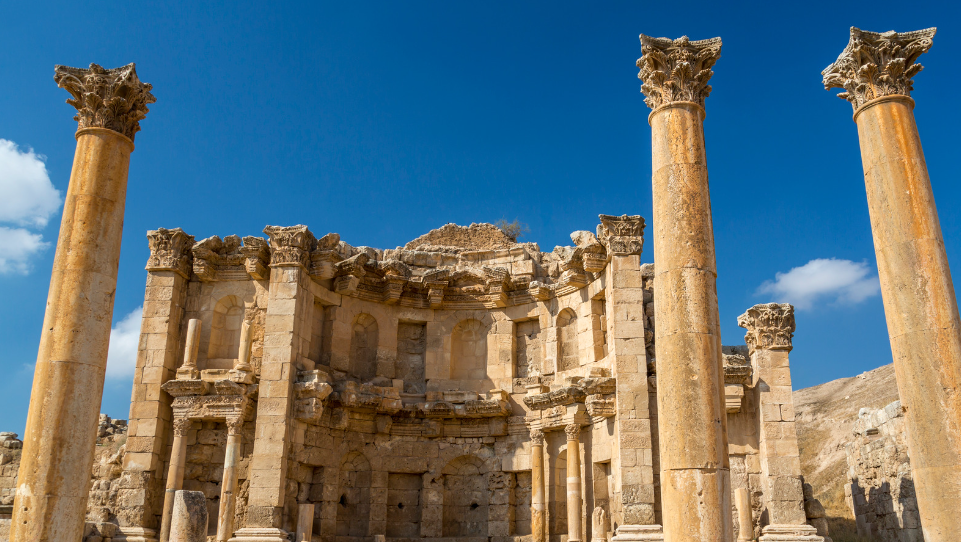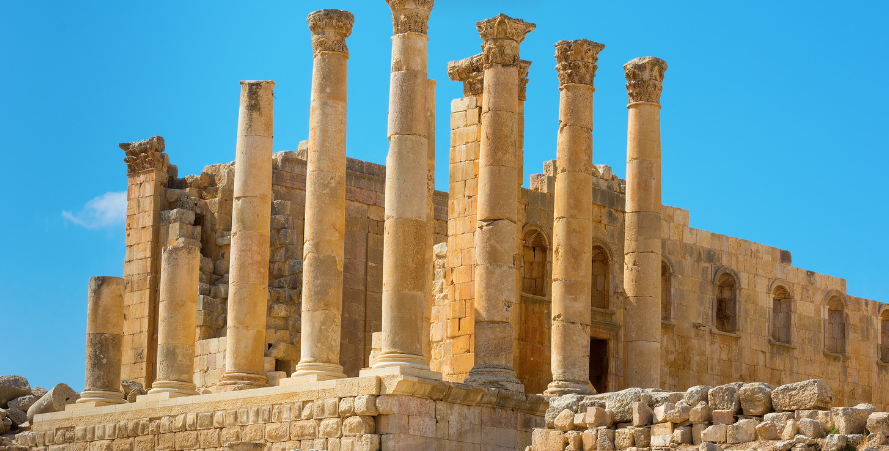Jerash Attractions: A Comprehensive Guide to Jordan’s Ancient Gem

Jerash and its attractions, nestled in the rolling hills of northern Jordan, is one of the most well-preserved Roman cities in the world. Renowned for its extensive ruins and historical significance, Jerash offers visitors a captivating glimpse into the grandeur of Roman urban life. With its ancient streets, temples, and theaters, Jerash stands as a testament to the architectural and cultural achievements of antiquity. This guide will navigate you through the must-see Jerash attractions, ensuring a memorable visit to this historical treasure.
The Ancient City of Jerash
The Oval Plaza
At the heart of Jerash lies the Oval Plaza, a spacious and elegantly designed forum that serves as the focal point of the ancient city. Surrounded by a colonnade of 160 columns, this impressive public square is a prime example of Roman urban planning. The plaza is flanked by important structures, including the Temple of Zeus and the South Theatre, creating a visually stunning and historically rich environment. The expansive space and its architectural harmony make it an ideal starting point for exploring the rest of Jerash.
Tip: Visit the Oval Plaza early in the day to enjoy the site with fewer crowds and better lighting for photography.
The Temple of Artemis
Located at the northern end of the Oval Plaza, the Temple of Artemis is one of the most significant religious structures in Jerash. Dedicated to Artemis, the goddess of the hunt, the temple was an important center of worship in the ancient city. Although much of the structure is in ruins, the remaining columns and intricately carved details provide a sense of the temple’s former grandeur. The site offers a glimpse into the religious and cultural life of Jerash’s inhabitants.
Tip: Take time to admire the remaining columns and architectural details, which highlight the temple’s classical design and craftsmanship.
The Theaters
The South Theatre
The South Theatre, also known as the Grand Theatre, is one of Jerash’s most remarkable and well-preserved structures. Built in the 2nd century AD, this amphitheater could accommodate up to 3,000 spectators. Its semi-circular seating arrangement and excellent acoustics make it an impressive example of Roman engineering. Today, the theater occasionally hosts cultural events and performances, allowing visitors to experience its historical significance in a contemporary context.
Tip: Sit in different sections of the theater to experience its renowned acoustics and imagine the lively performances that once took place here.
The North Theatre
Smaller but equally intriguing, the North Theatre is located near the Temple of Artemis. This theater, with a capacity of about 1,500 spectators, was used for various public performances and events. Its design is similar to that of the South Theatre but on a smaller scale. The North Theatre’s location near important religious and civic structures makes it a key element in understanding the social and cultural dynamics of ancient Jerash.
Tip: Explore both theaters to appreciate the scale and function of these ancient entertainment venues.

The Hadrian’s Arch
Triumphal Arch
Hadrian’s Arch, also known as the Triumphal Arch, is a monumental gateway dedicated to Emperor Hadrian, who visited Jerash in AD 129. This impressive archway was erected to commemorate his visit and mark the entrance to the city. Although partially in ruins, the arch’s massive columns and intricate carvings still evoke a sense of grandeur and historical significance. The arch serves as a symbolic entry point into the ancient city, reflecting the importance of Jerash during the Roman period.
Tip: Take a walk around the arch to view its details from different angles and appreciate its historical importance.
The Cardo Maximus
Main Street
The Cardo Maximus, or the main street, is a central thoroughfare that once served as the primary commercial and administrative axis of Jerash. Lined with columns and flanked by various shops and public buildings, this broad street provides insight into the city’s layout and urban planning. Walking along the Cardo Maximus offers a sense of the bustling activity that characterized ancient Jerash, with its vibrant marketplaces and civic buildings.
Tip: Walk the length of the Cardo Maximus to visualize the bustling activity and commerce that once took place along this important street.
The Nymphaeum
Fountain Complex
The Nymphaeum is a beautifully preserved fountain complex dedicated to the nymphs, water deities in Roman mythology. This elaborate structure was designed to provide a continuous supply of water to the city and served both functional and decorative purposes. The Nymphaeum features a grand façade adorned with columns and intricate carvings, reflecting the importance of water in ancient urban life.
Tip: Examine the fountain’s detailed carvings and architectural features to understand its role in both practical and ceremonial aspects of life in Jerash.
The Byzantine Church
Early Christian Church
Among the ruins of Jerash, the remains of an early Christian church offer a glimpse into the city’s religious transition from paganism to Christianity. The church, with its mosaic floors and well-preserved apse, reflects the architectural and artistic style of the Byzantine period. The church’s location within the ancient city highlights the changes in religious practices and the integration of Christianity into the urban fabric of Jerash.
Tip: Pay close attention to the mosaic floors, which depict various Christian symbols and provide insight into early Christian art.
The Temple of Zeus
Religious Sanctuary
The Temple of Zeus, located on the southern edge of the Oval Plaza, was one of the most important religious sites in ancient Jerash. Dedicated to Zeus, the king of the gods, the temple was a center of worship and civic activities. Though only remnants of the temple remain, the site’s massive columns and architectural fragments offer a glimpse into its former splendor.
Tip: Explore the surrounding area to see how the temple’s location and design influenced the layout of the nearby structures.
The South Gate
Ancient Entrance
The South Gate, also known as the Hadrian’s Gate, served as one of the main entrances to the ancient city. This imposing gateway was designed to impress visitors and mark the city’s significance within the Roman Empire. The gate’s surviving arches and columns provide a sense of the grandeur and strategic importance of Jerash during its peak.
Tip: Stand at the gate and imagine the bustling activity of travelers and traders entering the city through this grand entrance.
Practical Tips for Visiting Jerash
- Timing Your Visit: The best time to visit Jerash is during the cooler months of spring and autumn. Summer temperatures can be quite high, so visiting in the early morning or late afternoon can be more comfortable.
- Footwear: Wear comfortable walking shoes, as exploring the ruins involves significant walking over uneven terrain.
- Guided Tours: Consider hiring a local guide to gain deeper insights into the history and significance of the various sites. Guided tours can enhance your understanding and provide context to the ruins.
- Refreshments: Bring water and snacks, as amenities within the archaeological site are limited.
- Respect for Preservation: Follow the site’s guidelines to help preserve the ancient structures. Avoid touching or climbing on the ruins to protect their integrity.
Jerash attractions stand as a remarkable testament to the grandeur of Roman architecture and urban planning. From its monumental Oval Plaza and impressive theaters to its intricate temples and historical gateways, the city offers a captivating journey through antiquity. As you explore the ruins, take time to appreciate the architectural ingenuity and historical significance that make Jerash one of Jordan’s most cherished archaeological sites. Whether you’re a history enthusiast or a casual traveler, Jerash promises a memorable and enriching experience that connects you with the echoes of the past.
FAQ
How much time do you need to see Jerash?
To explore Jerash thoroughly, you’ll typically need about 3 to 4 hours. If you have a particular interest in Roman history or archaeology, you might want to spend a bit more time exploring and delving into the details. For a general visit, 3 to 4 hours is usually sufficient to see the main highlights.
Is Jerash mentioned in the Bible?
Yes, Jerash is mentioned in the Bible, though it is referred to by its ancient name, Gerasa. In the New Testament, specifically in the Gospels, Gerasa is mentioned in the context of the story of the Gadarene (or Gerasene) demoniac.
In the Gospel of Mark (5:1) and the Gospel of Luke (8:26), the story describes Jesus healing a man possessed by demons in the region of the Gerasenes. The demons are cast into a herd of pigs, which then rush down a steep bank into a lake and drown. The exact location of this event is debated, but Gerasa (Jerash) is traditionally associated with it.